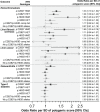Genetic modifiers of penetrance to liver endpoints in HFE hemochromatosis: Associations in a large community cohort
- PMID: 35567766
- PMCID: PMC9796074
- DOI: 10.1002/hep.32575
Genetic modifiers of penetrance to liver endpoints in HFE hemochromatosis: Associations in a large community cohort
Abstract
Background: The iron overload condition hereditary hemochromatosis (HH) can cause liver cirrhosis and cancer, diabetes, and arthritis. Males homozygous for the p.C282Y missense mutation in the Homeostatin Iron Regulator (HFE) gene have greatest risk; yet, only a minority develop these conditions. We aimed to determine whether common genetic variants influencing iron levels or liver disease risk in the general population also modify clinical penetrance in HFE p.C282Y and p.H63D carriers.
Methods: We studied 1294 male and 1596 female UK Biobank HFE p.C282Y homozygous participants of European ancestry with medical records up to 14 years after baseline assessment. Polygenic scores quantified genetic effects of blood iron biomarkers and relevant diseases (identified in the general population). Analyses were also performed in other HFE p.C282Y/p.H63D genotype groups.
Results: In male p.C282Y homozygotes, a higher iron polygenic score increased the risk of liver fibrosis or cirrhosis diagnoses (odds ratio for the top 20% of iron polygenic score vs. the bottom 20% = 4.90: 95% confidence intervals, 1.63-14.73; p = 0.005), liver cancer, and osteoarthritis but not diabetes. A liver cirrhosis polygenic score was associated with liver cancer diagnoses. In female p.C282Y homozygotes, the osteoarthritis polygenic score was associated with increased osteoarthritis diagnoses and type-2 diabetes polygenic score with diabetes. However, the iron polygenic score was not robustly associated with diagnoses in p.C282Y female homozygotes or in other p.C282Y/p.H63D genotypes.
Conclusions: HFE p.C282Y homozygote penetrance to clinical disease in a large community cohort was partly explained by common genetic variants that influence iron and risks of related diagnoses in the general population, including polygenic scores in HH screening and diagnosis, may help in estimating prognosis and treatment planning.
© 2022 The Authors. Hepatology published by Wiley Periodicals LLC on behalf of American Association for the Study of Liver Diseases.
Conflict of interest statement
All authors declare no conflicts of interest.
Figures




Similar articles
-
Penetrance of the C28Y/C282Y genotype of the HFE gene.Scand J Gastroenterol. 2007 Sep;42(9):1073-7. doi: 10.1080/00365520701245488. Scand J Gastroenterol. 2007. PMID: 17710673
-
[Molecular genetic diagnostics and screening of hereditary hemochromatosis].Vnitr Lek. 2006 Jun;52(6):602-8. Vnitr Lek. 2006. PMID: 16871764 Slovak.
-
Evaluation of genome-wide loci of iron metabolism in hereditary hemochromatosis identifies PCSK7 as a host risk factor of liver cirrhosis.Hum Mol Genet. 2014 Jul 15;23(14):3883-90. doi: 10.1093/hmg/ddu076. Epub 2014 Feb 20. Hum Mol Genet. 2014. PMID: 24556216
-
Contribution of different HFE genotypes to iron overload disease: a pooled analysis.Genet Med. 2000 Sep-Oct;2(5):271-7. doi: 10.1097/00125817-200009000-00001. Genet Med. 2000. PMID: 11399207 Review.
-
HFE gene and hereditary hemochromatosis: a HuGE review. Human Genome Epidemiology.Am J Epidemiol. 2001 Aug 1;154(3):193-206. doi: 10.1093/aje/154.3.193. Am J Epidemiol. 2001. PMID: 11479183 Review.
Cited by
-
Association between serum iron status and the risk of five bone and joint-related diseases: a Mendelian randomization analysis.Front Endocrinol (Lausanne). 2024 Sep 13;15:1364375. doi: 10.3389/fendo.2024.1364375. eCollection 2024. Front Endocrinol (Lausanne). 2024. PMID: 39345879 Free PMC article.
-
Iron overload is not the same everywhere: Particularities of iron-metabolism gene mutations in Brazil and a proposal for the investigation and management of iron overload in this population.Hematol Transfus Cell Ther. 2025 Apr-Jun;47(2):103846. doi: 10.1016/j.htct.2025.103846. Epub 2025 May 15. Hematol Transfus Cell Ther. 2025. PMID: 40378601 Free PMC article. Review.
-
Hemochromatosis Genetic Variants and Musculoskeletal Outcomes: 11.5-Year Follow-Up in the UK Biobank Cohort Study.JBMR Plus. 2023 Jul 18;7(10):e10794. doi: 10.1002/jbm4.10794. eCollection 2023 Oct. JBMR Plus. 2023. PMID: 37808392 Free PMC article.
-
HJV mutations causing hemochromatosis: variable phenotypic expression in a pair of twins.Haematologica. 2024 Aug 1;109(8):2741-2744. doi: 10.3324/haematol.2023.284134. Haematologica. 2024. PMID: 38450514 Free PMC article. No abstract available.
-
Diagnosis and management of hereditary hemochromatosis: lifestyle modification, phlebotomy, and blood donation.Hematology Am Soc Hematol Educ Program. 2024 Dec 6;2024(1):434-442. doi: 10.1182/hematology.2024000568. Hematology Am Soc Hematol Educ Program. 2024. PMID: 39644049 Free PMC article. Review.
References
Publication types
MeSH terms
Substances
Grants and funding
LinkOut - more resources
Full Text Sources
Medical

